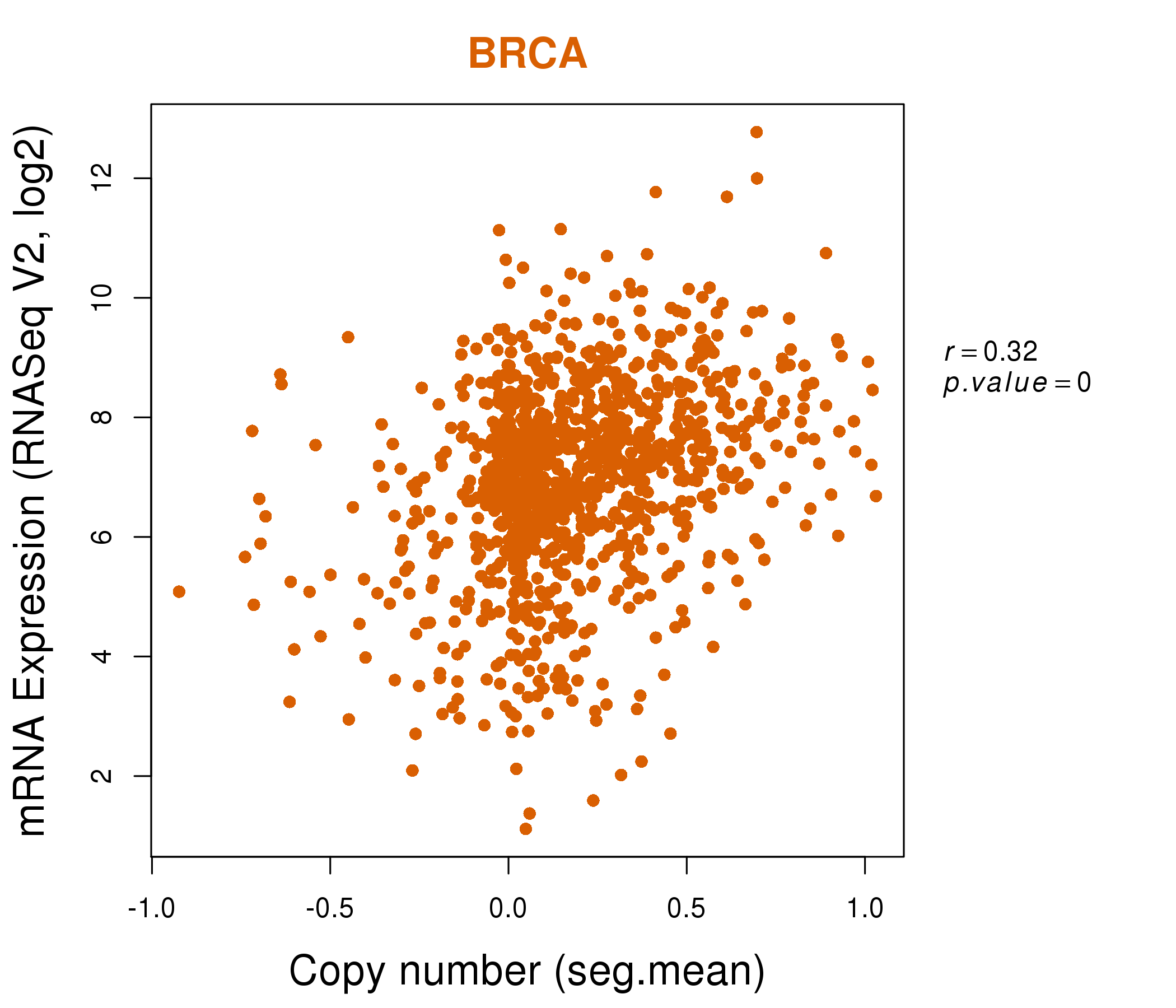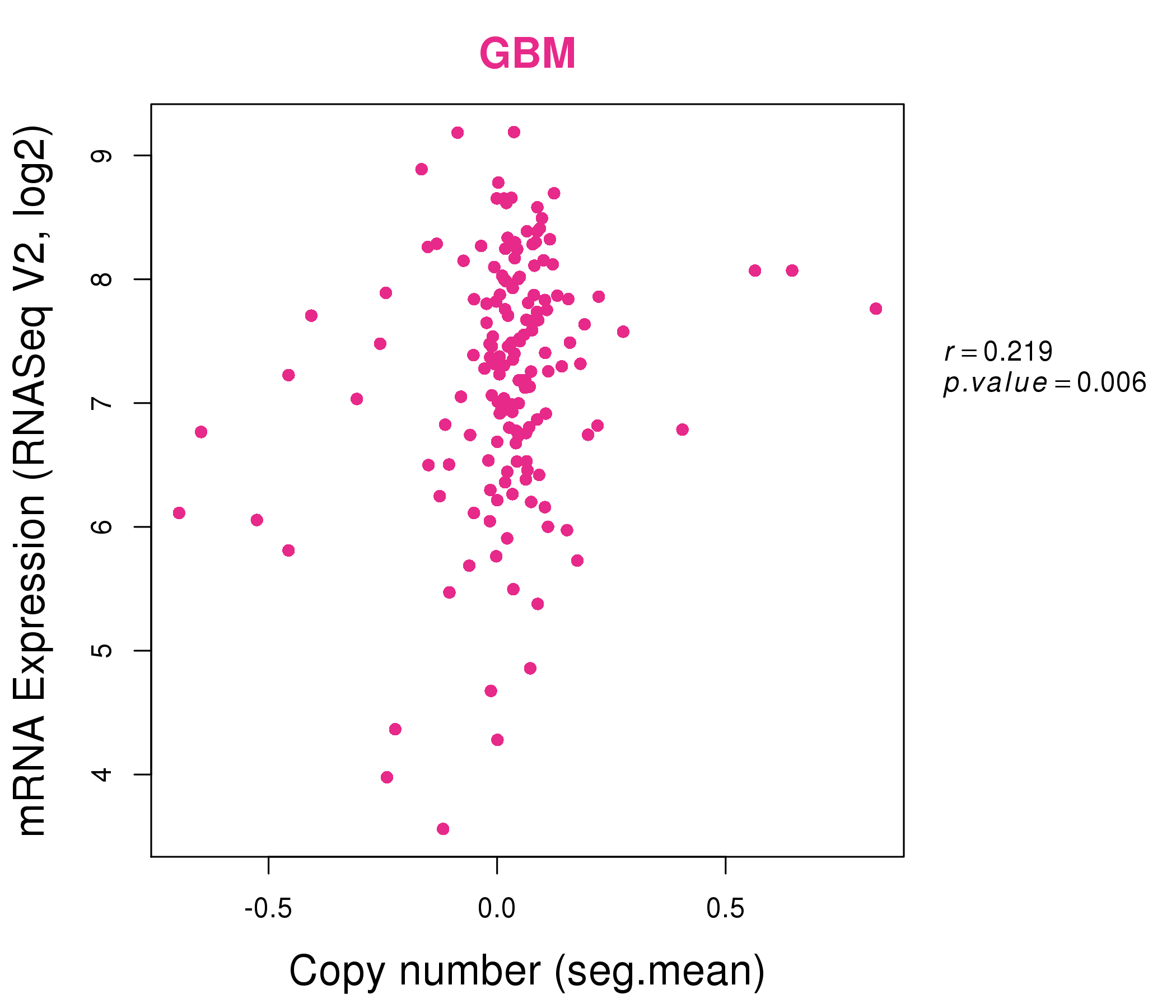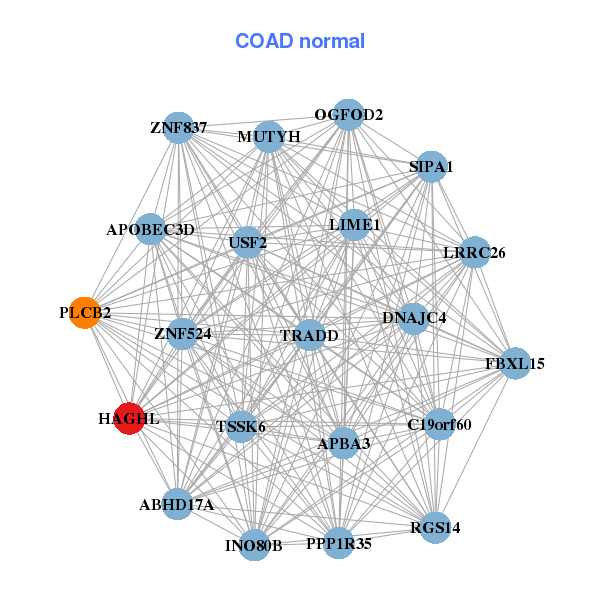|
||||||||||||||||||||
| |
| Phenotypic Information (metabolism pathway, cancer, disease, phenome) |
| |
| |
| Gene-Gene Network Information: Co-Expression Network, Interacting Genes & KEGG |
| |
|
| Gene Summary for HAGHL |
| Top |
| Phenotypic Information for HAGHL(metabolism pathway, cancer, disease, phenome) |
| Cancer | CGAP: HAGHL |
| Familial Cancer Database: HAGHL | |
| * This gene is included in those cancer gene databases. |
|
|
|
|
|
|
| ||||||||||||||
Oncogene 1 | Significant driver gene in | |||||||||||||||||||
| cf) number; DB name 1 Oncogene; http://nar.oxfordjournals.org/content/35/suppl_1/D721.long, 2 Tumor Suppressor gene; https://bioinfo.uth.edu/TSGene/, 3 Cancer Gene Census; http://www.nature.com/nrc/journal/v4/n3/abs/nrc1299.html, 4 CancerGenes; http://nar.oxfordjournals.org/content/35/suppl_1/D721.long, 5 Network of Cancer Gene; http://ncg.kcl.ac.uk/index.php, 1Therapeutic Vulnerabilities in Cancer; http://cbio.mskcc.org/cancergenomics/statius/ |
| KEGG_PYRUVATE_METABOLISM | |
| OMIM | |
| Orphanet | |
| Disease | KEGG Disease: HAGHL |
| MedGen: HAGHL (Human Medical Genetics with Condition) | |
| ClinVar: HAGHL | |
| Phenotype | MGI: HAGHL (International Mouse Phenotyping Consortium) |
| PhenomicDB: HAGHL | |
| Mutations for HAGHL |
| * Under tables are showing count per each tissue to give us broad intuition about tissue specific mutation patterns.You can go to the detailed page for each mutation database's web site. |
| There's no structural variation information in COSMIC data for this gene. |
| * From mRNA Sanger sequences, Chitars2.0 arranged chimeric transcripts. This table shows HAGHL related fusion information. |
| ID | Head Gene | Tail Gene | Accession | Gene_a | qStart_a | qEnd_a | Chromosome_a | tStart_a | tEnd_a | Gene_a | qStart_a | qEnd_a | Chromosome_a | tStart_a | tEnd_a |
| AK128330 | SLC38A10 | 1 | 2903 | 17 | 79220415 | 79259514 | HAGHL | 2901 | 3188 | 16 | 779428 | 779715 | |
| AB209331 | HAGHL | 1 | 952 | 16 | 777131 | 778868 | DHX38 | 950 | 1083 | 16 | 72146677 | 72146810 | |
| DB345864 | HAGHL | 1 | 288 | 16 | 779428 | 779715 | SLC38A10 | 286 | 551 | 17 | 79220415 | 79225322 | |
| Top |
| There's no copy number variation information in COSMIC data for this gene. |
| Top |
|
 |
| Top |
| Stat. for Non-Synonymous SNVs (# total SNVs=9) | (# total SNVs=4) |
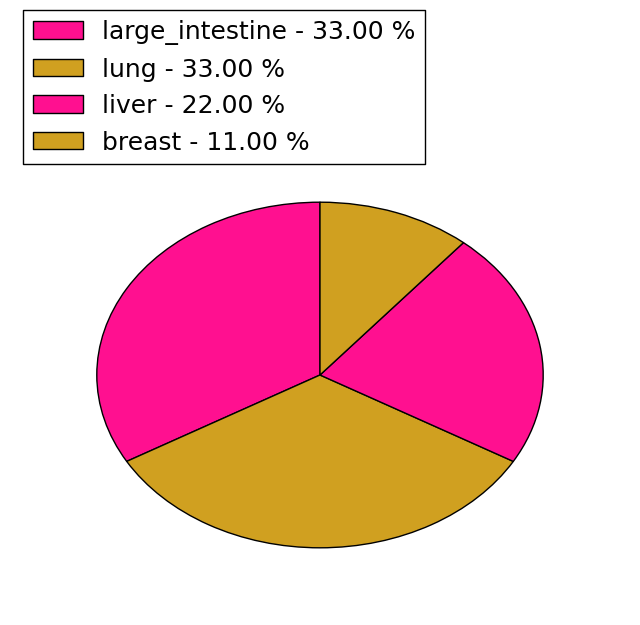 | 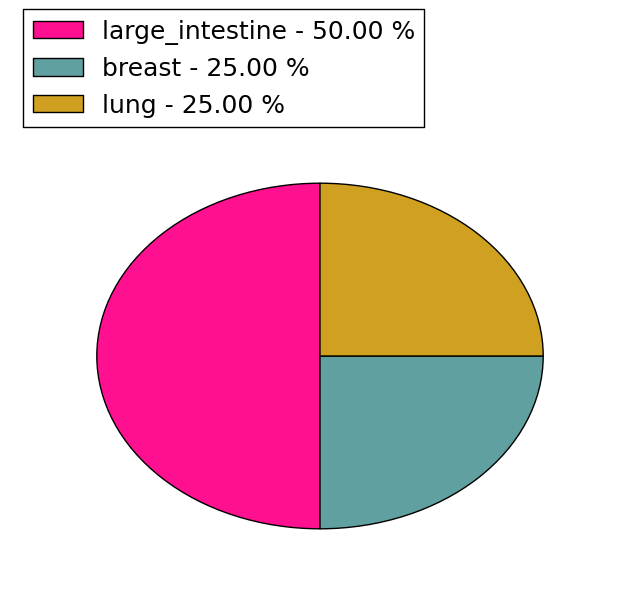 |
(# total SNVs=6) | (# total SNVs=2) |
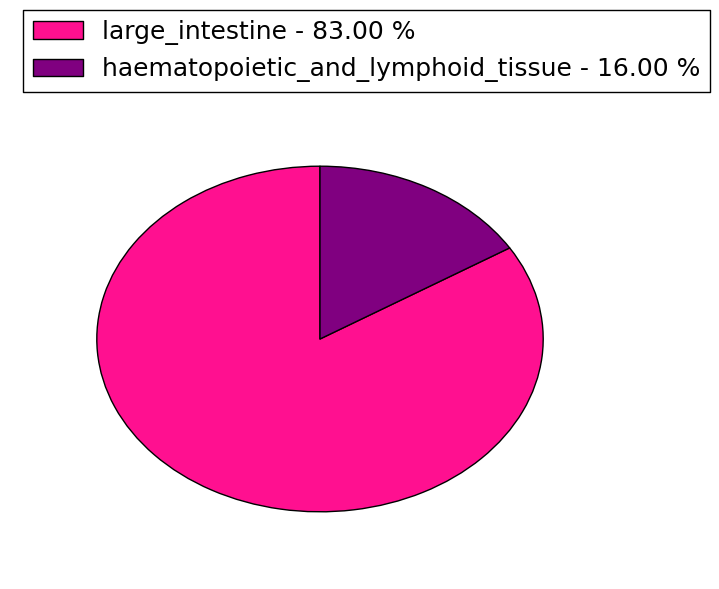 | 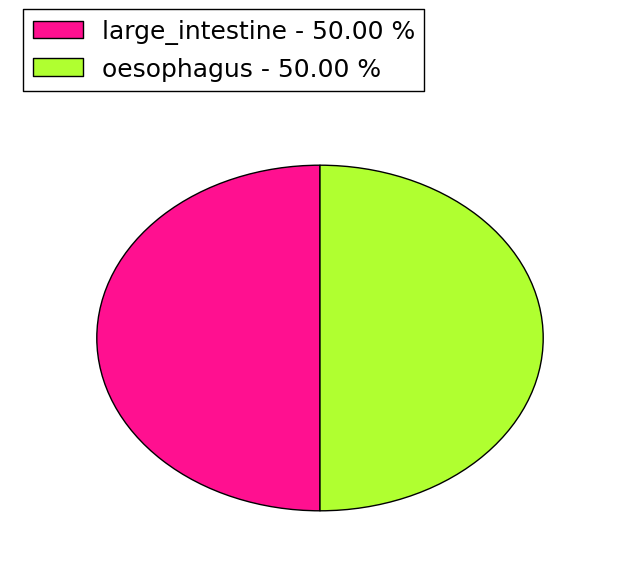 |
| Top |
| * When you move the cursor on each content, you can see more deailed mutation information on the Tooltip. Those are primary_site,primary_histology,mutation(aa),pubmedID. |
| GRCh37 position | Mutation(aa) | Unique sampleID count |
| chr16:778928-778928 | p.E214fs*15 | 6 |
| chr16:778820-778820 | p.T175T | 2 |
| chr16:778863-778863 | p.D190N | 2 |
| chr16:777510-777510 | p.M1V | 2 |
| chr16:778952-778952 | p.G219G | 2 |
| chr16:779048-779048 | p.L251L | 2 |
| chr16:778024-778024 | p.H55H | 2 |
| chr16:779062-779062 | p.A256D | 1 |
| chr16:778158-778158 | p.P71P | 1 |
| chr16:779103-779103 | p.C270R | 1 |
| Top |
|
 |
| Point Mutation/ Tissue ID | 1 | 2 | 3 | 4 | 5 | 6 | 7 | 8 | 9 | 10 | 11 | 12 | 13 | 14 | 15 | 16 | 17 | 18 | 19 | 20 |
| # sample | 2 | 1 | 2 | |||||||||||||||||
| # mutation | 3 | 1 | 2 | |||||||||||||||||
| nonsynonymous SNV | 3 | 1 | ||||||||||||||||||
| synonymous SNV | 2 |
| cf) Tissue ID; Tissue type (1; BLCA[Bladder Urothelial Carcinoma], 2; BRCA[Breast invasive carcinoma], 3; CESC[Cervical squamous cell carcinoma and endocervical adenocarcinoma], 4; COAD[Colon adenocarcinoma], 5; GBM[Glioblastoma multiforme], 6; Glioma Low Grade, 7; HNSC[Head and Neck squamous cell carcinoma], 8; KICH[Kidney Chromophobe], 9; KIRC[Kidney renal clear cell carcinoma], 10; KIRP[Kidney renal papillary cell carcinoma], 11; LAML[Acute Myeloid Leukemia], 12; LUAD[Lung adenocarcinoma], 13; LUSC[Lung squamous cell carcinoma], 14; OV[Ovarian serous cystadenocarcinoma ], 15; PAAD[Pancreatic adenocarcinoma], 16; PRAD[Prostate adenocarcinoma], 17; SKCM[Skin Cutaneous Melanoma], 18:STAD[Stomach adenocarcinoma], 19:THCA[Thyroid carcinoma], 20:UCEC[Uterine Corpus Endometrial Carcinoma]) |
| Top |
| * We represented just top 10 SNVs. When you move the cursor on each content, you can see more deailed mutation information on the Tooltip. Those are primary_site, primary_histology, mutation(aa), pubmedID. |
| Genomic Position | Mutation(aa) | Unique sampleID count |
| chr16:778875 | p.R218R,HAGHL | 1 |
| chr16:779062 | p.V5V,HAGHL | 1 |
| chr16:777524 | p.E24K,HAGHL | 1 |
| chr16:777579 | p.V30M,HAGHL | 1 |
| chr16:777597 | p.V30G,HAGHL | 1 |
| chr16:777598 | p.A194S,HAGHL | 1 |
| * Copy number data were extracted from TCGA using R package TCGA-Assembler. The URLs of all public data files on TCGA DCC data server were gathered on Jan-05-2015. Function ProcessCNAData in TCGA-Assembler package was used to obtain gene-level copy number value which is calculated as the average copy number of the genomic region of a gene. |
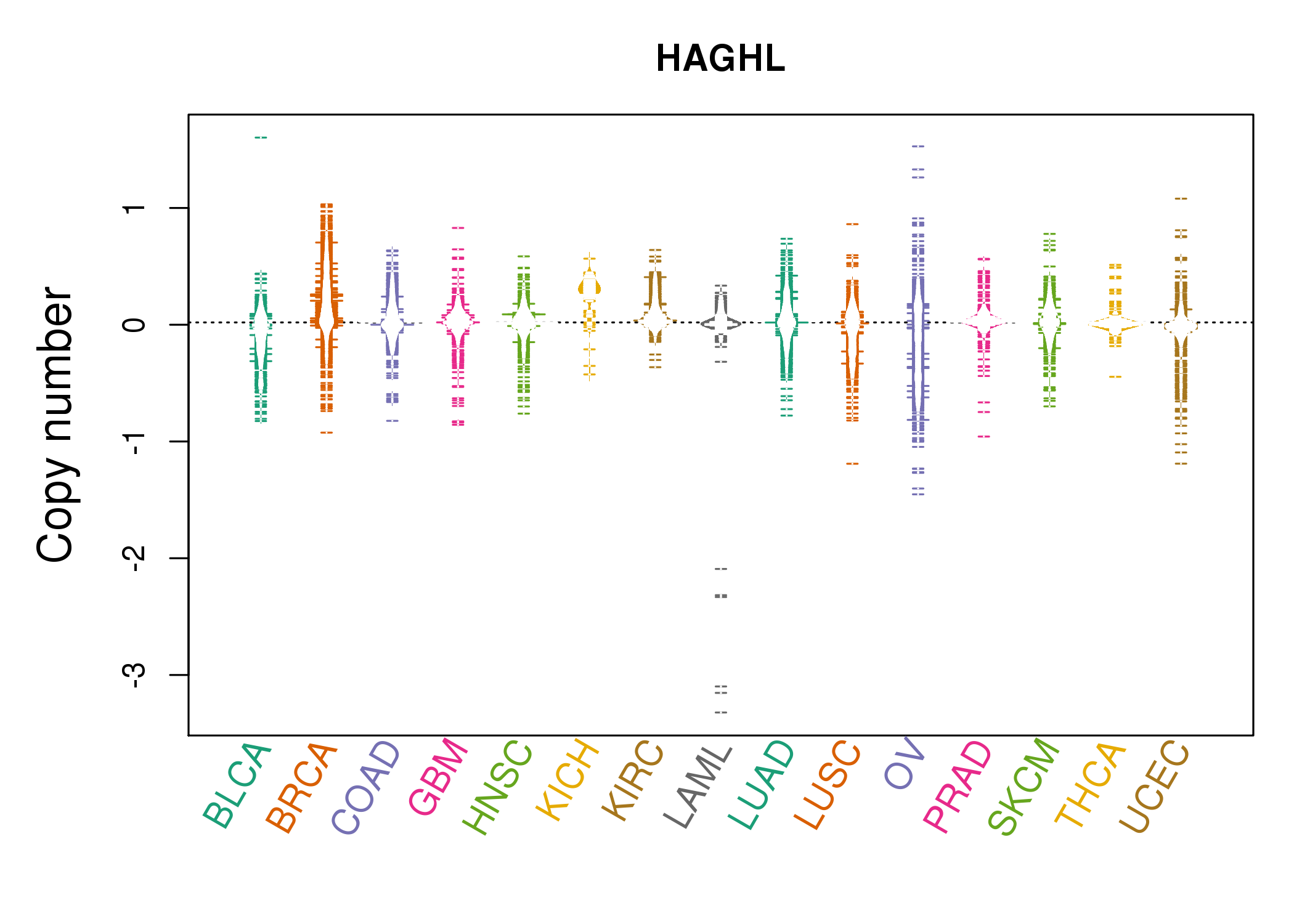 |
| cf) Tissue ID[Tissue type]: BLCA[Bladder Urothelial Carcinoma], BRCA[Breast invasive carcinoma], CESC[Cervical squamous cell carcinoma and endocervical adenocarcinoma], COAD[Colon adenocarcinoma], GBM[Glioblastoma multiforme], Glioma Low Grade, HNSC[Head and Neck squamous cell carcinoma], KICH[Kidney Chromophobe], KIRC[Kidney renal clear cell carcinoma], KIRP[Kidney renal papillary cell carcinoma], LAML[Acute Myeloid Leukemia], LUAD[Lung adenocarcinoma], LUSC[Lung squamous cell carcinoma], OV[Ovarian serous cystadenocarcinoma ], PAAD[Pancreatic adenocarcinoma], PRAD[Prostate adenocarcinoma], SKCM[Skin Cutaneous Melanoma], STAD[Stomach adenocarcinoma], THCA[Thyroid carcinoma], UCEC[Uterine Corpus Endometrial Carcinoma] |
| Top |
| Gene Expression for HAGHL |
| * CCLE gene expression data were extracted from CCLE_Expression_Entrez_2012-10-18.res: Gene-centric RMA-normalized mRNA expression data. |
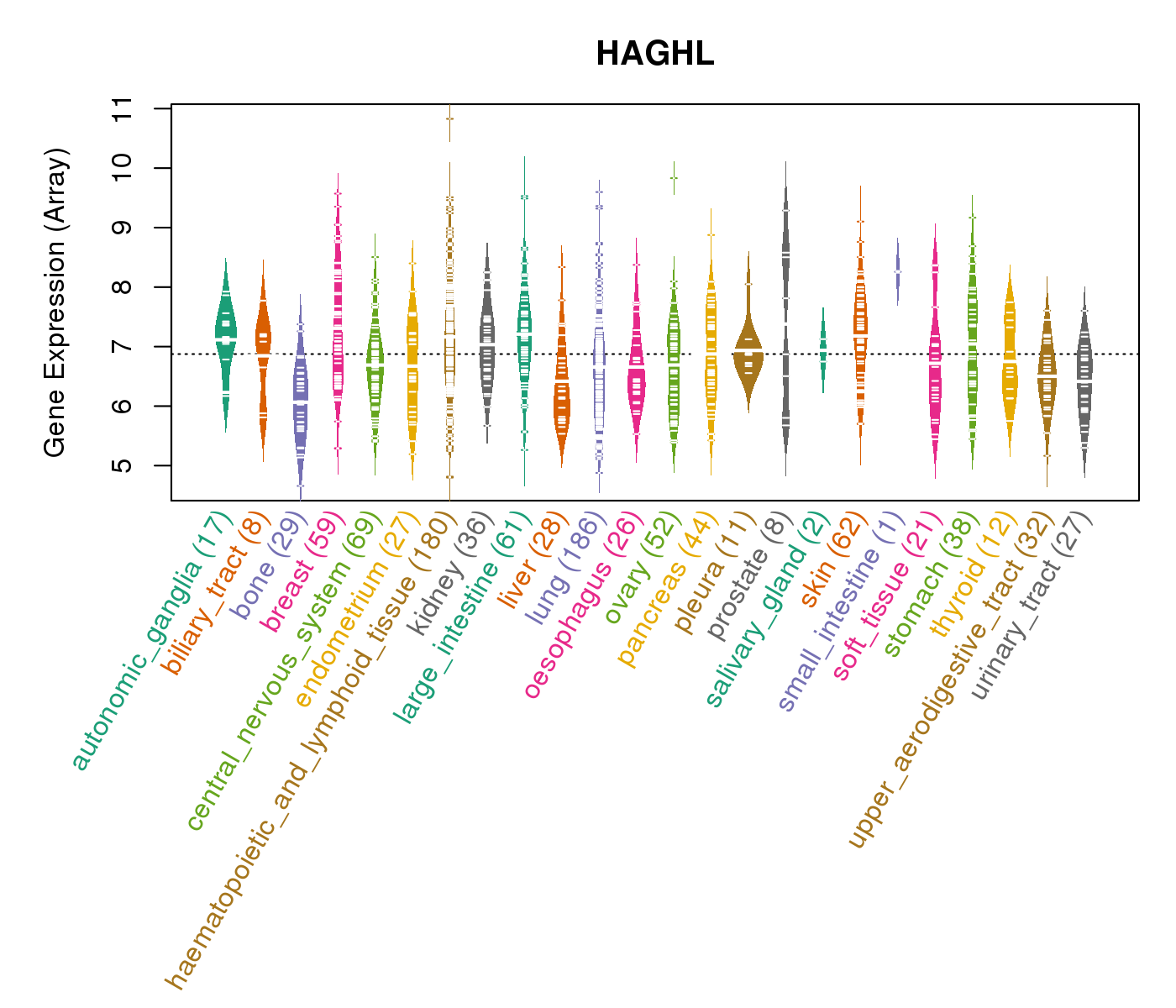 |
| * Normalized gene expression data of RNASeqV2 was extracted from TCGA using R package TCGA-Assembler. The URLs of all public data files on TCGA DCC data server were gathered at Jan-05-2015. Only eight cancer types have enough normal control samples for differential expression analysis. (t test, adjusted p<0.05 (using Benjamini-Hochberg FDR)) |
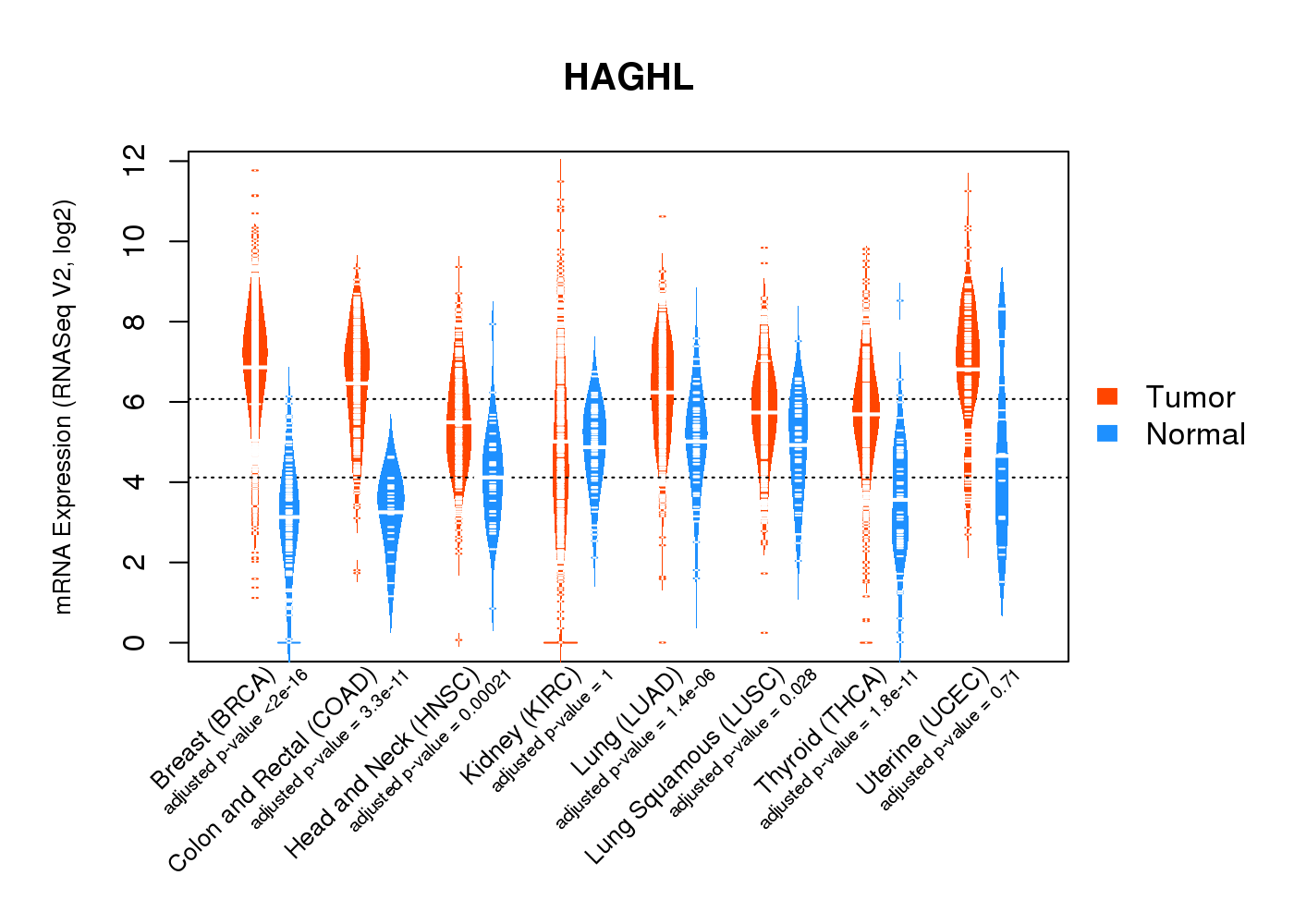 |
| Top |
| * This plots show the correlation between CNV and gene expression. |
: Open all plots for all cancer types
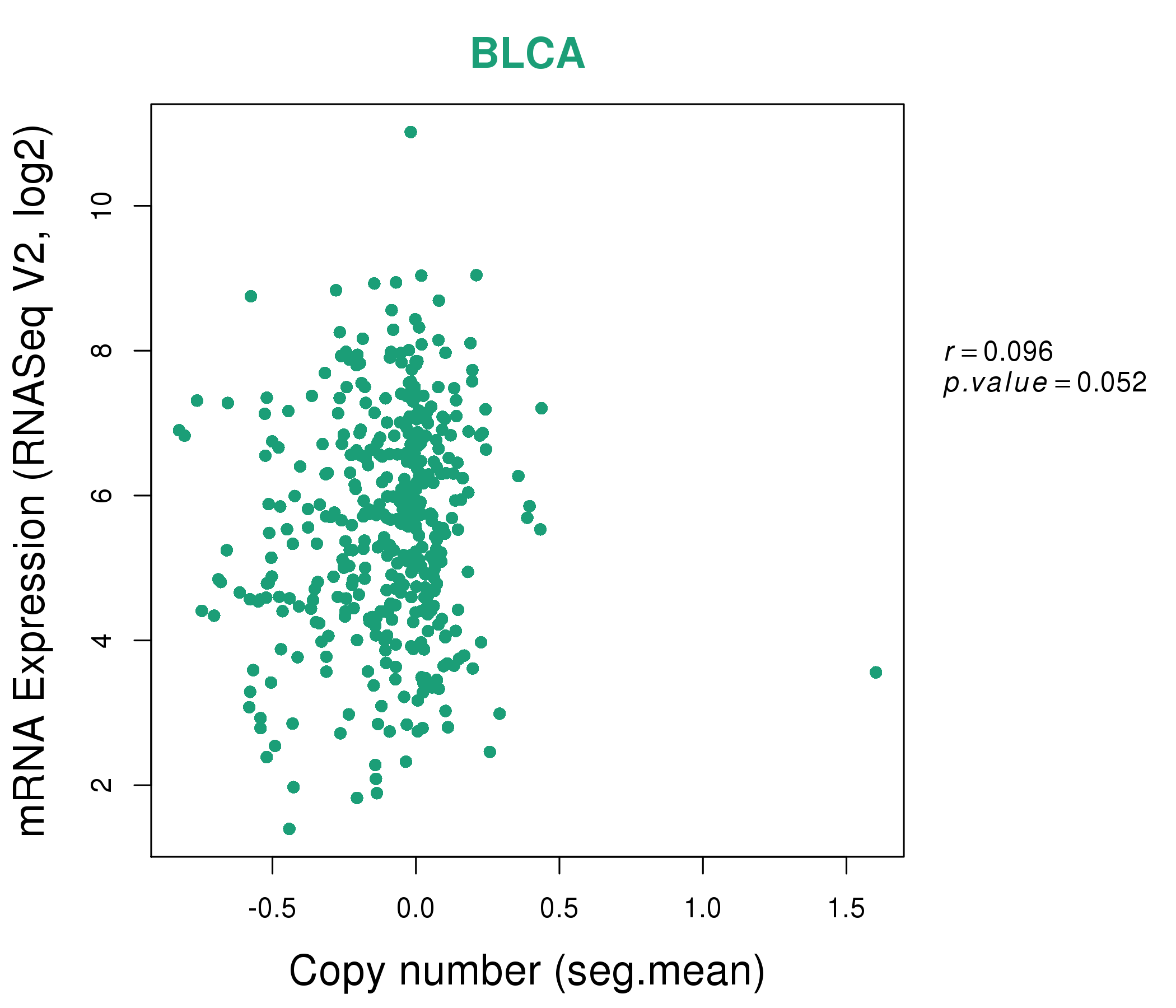 |
|
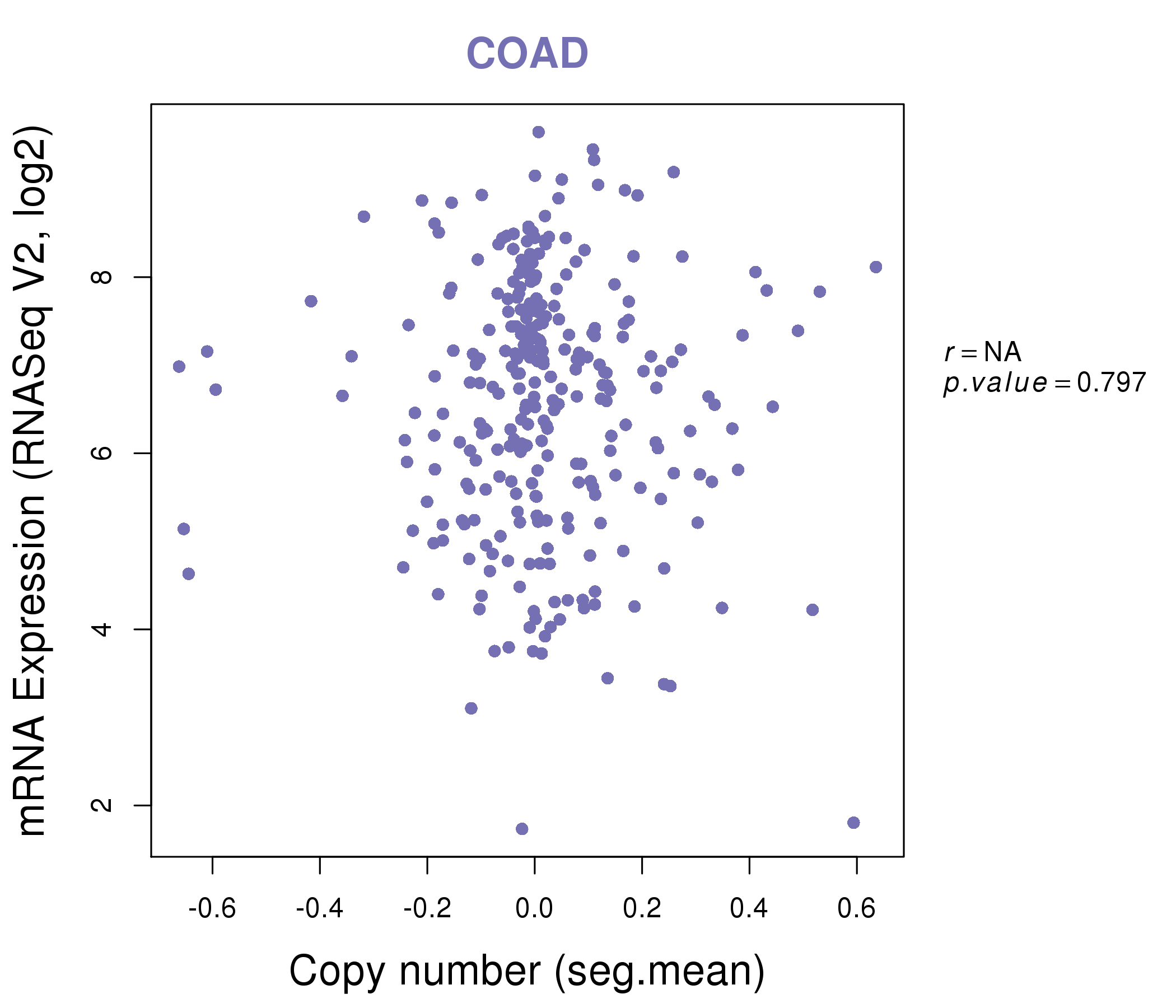 |
|
| Top |
| Gene-Gene Network Information |
| * Co-Expression network figures were drawn using R package igraph. Only the top 20 genes with the highest correlations were shown. Red circle: input gene, orange circle: cell metabolism gene, sky circle: other gene |
: Open all plots for all cancer types
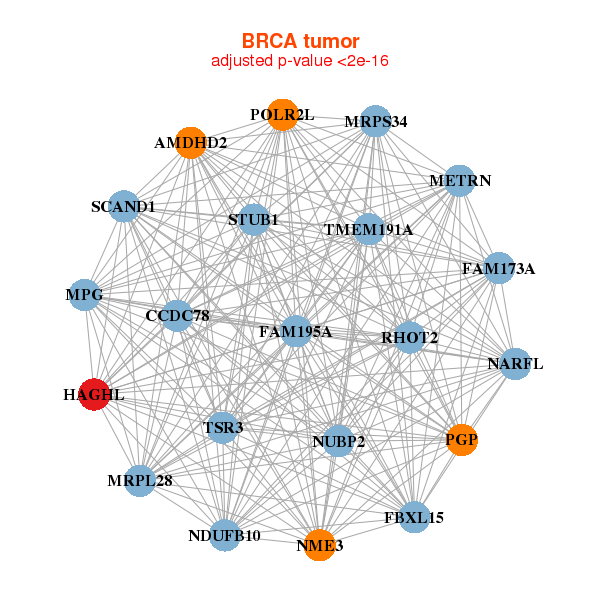 |
|
| AMDHD2,TSR3,CCDC78,FAM173A,FAM195A,FBXL15,HAGHL, METRN,MPG,MRPL28,MRPS34,NARFL,NDUFB10,NME3, NUBP2,PGP,POLR2L,RHOT2,SCAND1,STUB1,TMEM191A | ADCK5,B4GALNT4,C16orf59,CLN6,DCTPP1,FBXL6,FEN1, GALE,SLC52A2,HAGHL,MAZ,METRN,PAFAH1B3,PAQR4, PUS1,PYCRL,RECQL4,RHPN1,RNASEH2A,TPRN,TRIM11 |
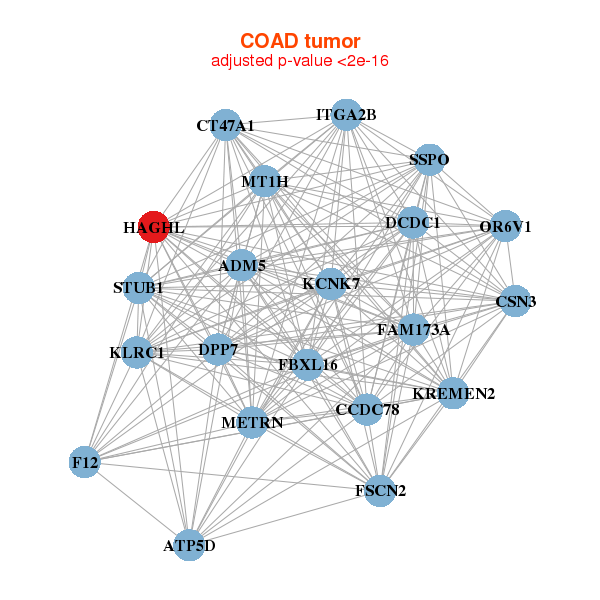 |
|
| ATP5D,ADM5,CCDC78,CSN3,CT47A1,DCDC1,DPP7, F12,FAM173A,FBXL16,FSCN2,HAGHL,ITGA2B,KCNK7, KLRC1,KREMEN2,METRN,MT1H,OR6V1,SSPO,STUB1 | APBA3,APOBEC3D,C19orf60,PPP1R35,DNAJC4,ABHD17A,FBXL15, HAGHL,INO80B,LIME1,LRRC26,MUTYH,OGFOD2,PLCB2, RGS14,SIPA1,TRADD,TSSK6,USF2,ZNF524,ZNF837 |
| * Co-Expression network figures were drawn using R package igraph. Only the top 20 genes with the highest correlations were shown. Red circle: input gene, orange circle: cell metabolism gene, sky circle: other gene |
: Open all plots for all cancer types
| Top |
: Open all interacting genes' information including KEGG pathway for all interacting genes from DAVID
| Top |
| Pharmacological Information for HAGHL |
| There's no related Drug. |
| Top |
| Cross referenced IDs for HAGHL |
| * We obtained these cross-references from Uniprot database. It covers 150 different DBs, 18 categories. http://www.uniprot.org/help/cross_references_section |
: Open all cross reference information
|
Copyright © 2016-Present - The Univsersity of Texas Health Science Center at Houston @ |






